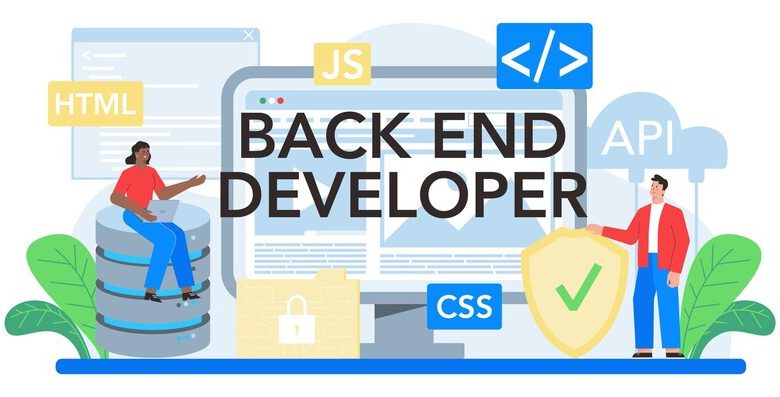
How Back-End Developers Work: Web and Mobile Development
How back-end developers work, Back-end developers play a vital role in the development of web applications, working behind the scenes to ensure the functionality, security, and performance of the software. Their work involves various tasks, ranging from server-side scripting to database management and API integration. In the dynamic world of web development, back-end development serves as the engine that powers the functionality and performance of applications ranging from web to mobile. From managing data and user authentication to optimizing performance and integrating external services, back-end developers play a crucial role in ensuring the seamless operation of digital platforms. Read more with coursera and who is a frontend developers, click the link to know more infoteck

Requirement for all backend developers
how back-end developers work
- Understanding Requirements: Back-end developers begin by understanding the project requirements and the overall goals of the web application. They collaborate with front-end developers, designers, and other stakeholders to gain insights into the features and functionalities needed.
- Choosing Technology Stack: Based on the project requirements, back-end developers choose a suitable technology stack, including programming languages, frameworks, and databases. The selection depends on factors like scalability, performance, and the specific needs of the application.
- Setting Up the Development Environment: Back-end developers set up their development environment, which includes configuring servers, databases, and any necessary tools or libraries. This step ensures a stable foundation for coding and testing.
- Database Design and Management: Back-end developers design the database schema to efficiently store and retrieve data. They create tables, establish relationships between entities, and optimize queries for better performance. Database management also involves ensuring data integrity and security.
- Server-Side Scripting: Back-end developers write server-side code to handle requests from the front end. This code is responsible for executing business logic, processing data, and generating dynamic content. Common programming languages for server-side scripting include Python, Java, Ruby, and Node.js.
- API Development: Developing Application Programming Interfaces (APIs) is a crucial aspect of back-end development. APIs define how different software components should interact. Back-end developers create RESTful or GraphQL APIs to enable communication between the front end and back end.
- User Authentication and Authorization: Security is a top priority for back-end developers. They implement user authentication systems to verify user identities and authorization mechanisms to control access to different parts of the application. This involves techniques like password hashing and token-based authentication.
- Handling Server-Side Logic: Back-end developers implement server-side logic to process user inputs, perform calculations, and execute various tasks on the server. This includes validating form submissions, handling file uploads, and managing complex operations that should not be handled on the client side.
- Optimizing Performance: Back-end developers focus on optimizing the performance of the application. This involves analyzing and improving database queries, implementing caching strategies, and considering factors like load balancing to ensure the system can scale to handle increased traffic.
- Testing: Back-end developers conduct thorough testing of their code. This includes unit testing for individual components, integration testing to ensure different parts of the system work together, and performance testing to identify and address bottlenecks.
- Deployment: Once the development and testing phases are complete, back-end developers deploy the application to a production environment. This involves configuring servers, setting up databases, and ensuring that the application runs smoothly in a live environment.
- Monitoring and Maintenance: After deployment, back-end developers monitor the application for performance issues, security vulnerabilities, and other potential issues. They address bugs, apply updates, and continuously improve the system to meet changing requirements.
The Role of Back-End Development in Web Applications1
how back-end developers work
- Data Management: Back-end development is crucial for effective data management. It involves storing, retrieving, and manipulating data in a secure and organized manner. The back end ensures that data is structured correctly and remains consistent across the application.
- User Authentication and Authorization: Security is paramount in web development. Back-end developers implement user authentication systems to verify the identity of users and ensure that only authorized individuals have access to specific resources and functionalities.
- Server-Side Processing: Many operations, such as form submissions, file uploads, and complex calculations, are handled on the server side. Back-end development is responsible for executing these processes efficiently, ensuring a smooth and responsive user experience.
- Scalability and Performance: As web applications grow, scalability becomes a critical consideration. Back-end developers design systems that can handle increased traffic and data loads without compromising performance. This involves optimizing database queries, implementing caching strategies, and scaling server infrastructure as needed.
- Integration with Third-Party Services: Back-end development often involves integrating web applications with external services and APIs. Whether it’s payment gateways, social media platforms, or other third-party tools, back-end developers ensure seamless communication and data exchange between the application and external services.
Discover more from Infotech
Subscribe to get the latest posts sent to your email.





